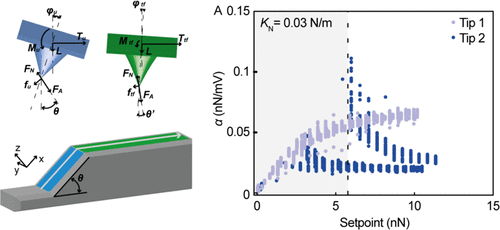当前位置:
X-MOL 学术
›
J. Phys. Chem. C
›
论文详情
Our official English website, www.x-mol.net, welcomes your feedback! (Note: you will need to create a separate account there.)
Detailed Study on the Failure of the Wedge Calibration Method at Nanonewton Setpoints for Friction Force Microscopy
The Journal of Physical Chemistry C ( IF 3.7 ) Pub Date : 2018-05-07 00:00:00 , DOI: 10.1021/acs.jpcc.8b03583 Roberto D. Ortuso 1 , Kaori Sugihara 1
The Journal of Physical Chemistry C ( IF 3.7 ) Pub Date : 2018-05-07 00:00:00 , DOI: 10.1021/acs.jpcc.8b03583 Roberto D. Ortuso 1 , Kaori Sugihara 1
Affiliation

|
The wedge calibration method is the most popular calibration technique in friction force microscopy for converting raw lateral laser deflection signals (in volt) into forces (in newton). Recent trends in nanotribology demand the use of the method at nanonewton (nN) force ranges; however, this method fails at these small forces. The objective of the present work is to identify the reason why the conventional wedge calibration method fails at nN force ranges. We found that the equation used in the model in this method amplifies experimental errors by orders of magnitude only at small setpoints purely due to its mathematical expression. This low tolerance against experimental errors in nanonewton force ranges is the reason for the failure. We identified that the condition, under which the method operates accurately, is adhesion ≪ setpoint. Discovery of this operation range (adhesion ≪ setpoint) is important because performing the calibration under other conditions can wrongly calibrate the system by orders of magnitude.
中文翻译:

楔形校准方法在纳米牛顿摩擦力设定点失效的详细研究
楔形校准方法是摩擦力显微镜中最流行的校准技术,用于将原始横向激光偏转信号(以伏特为单位)转换为力(以牛顿为单位)。纳米摩擦学的最新趋势要求在纳米牛顿(nN)力范围内使用该方法。但是,这种方法在这么小的作用力下失败了。本工作的目的是确定传统楔形校正方法在nN力范围内失效的原因。我们发现,纯粹由于其数学表达式,该方法在模型中使用的方程式仅在较小的设定点处将实验误差放大了几个数量级。对纳米牛顿力范围内的实验误差的低耐受性是失败的原因。我们确定了该方法准确运行的条件是附着力≪设定点。
更新日期:2018-05-07
中文翻译:

楔形校准方法在纳米牛顿摩擦力设定点失效的详细研究
楔形校准方法是摩擦力显微镜中最流行的校准技术,用于将原始横向激光偏转信号(以伏特为单位)转换为力(以牛顿为单位)。纳米摩擦学的最新趋势要求在纳米牛顿(nN)力范围内使用该方法。但是,这种方法在这么小的作用力下失败了。本工作的目的是确定传统楔形校正方法在nN力范围内失效的原因。我们发现,纯粹由于其数学表达式,该方法在模型中使用的方程式仅在较小的设定点处将实验误差放大了几个数量级。对纳米牛顿力范围内的实验误差的低耐受性是失败的原因。我们确定了该方法准确运行的条件是附着力≪设定点。


























 京公网安备 11010802027423号
京公网安备 11010802027423号